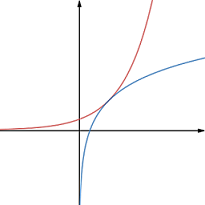Common Point

Find the value of positive number a such that curves y = a 1 e x and y = ln ( a x ) share only one common point.
The answer is 2.71828.
This section requires Javascript.
You are seeing this because something didn't load right. We suggest you, (a) try
refreshing the page, (b) enabling javascript if it is disabled on your browser and,
finally, (c)
loading the
non-javascript version of this page
. We're sorry about the hassle.
3 solutions
Note: The first line is not always true.
For example, y = 2 x , y = 2 1 x are inverse functions of each other that share a common point, but do not have a common tangent.
See the discussion here .
When two curves y 1 ( x ) and y 2 ( x ) share only one common point x 0 , then y 1 ( x 0 ) = y 2 ( x 0 ) and y 1 ′ ( x 0 ) = y 2 ′ ( x 0 ) . Therefore, we have:
⎩ ⎪ ⎨ ⎪ ⎧ y 1 ( x 0 ) = y 2 ( x 0 ) y 1 ′ ( x 0 ) = y 2 ′ ( x 0 ) ⟹ a e x 0 = ln a + ln x 0 ⟹ a e x 0 = x 0 1 ⟹ a = x 0 e x 0 . . . ( 1 ) . . . ( 2 )
Putting a = x 0 e x 0 in ( 1 ) ,
x 0 e x 0 e x 0 ⟹ x 0 1 = ln ( x 0 e x 0 ) + ln x 0 = 2 ln x 0 + x 0
We note that x 0 = 1 is the solution. Therefore a = x 0 e x 0 = e ≈ 2 . 7 1 8 .
Note: The first line is not always true.
See the discussion here .
There is a way to do this without using the Intuition and calculus at all and it involves the lambert w function.
W = f^{-1} where f(x) = xe^x Domain(W) = [-1/e , inf) However W is bivalued on (-1/e , 0) The graph is given by x=ye^y where W(-1/e)=-1
Now the two functions in the question are inverse functions. Hence any intersection between the two happens on the line y=x
Let the intersection point be (t,t) This implies
at=e^t te^{-t}=1/a -te^{-t}=-1/a
Taking W on both sides
W(-te^{-t})=W(-1/a) -t=W(-1/a) t=-W(-1/a)
Since the curves intersect exactly once, t must have exactly 1 solution. This is to say that -1/a must be in the single valued domain of the Lambert W function.
Therefore -1/a belongs to [-1/e,inf) And -1/a does not belong to (-1/e,0) Hence -1/a belongs to {-1/e}U[0,inf)
Case 1 -1/a belongs to [0,inf) -1/a >= 0 1/a <= 0 a <= 0 However this is not possible as a>0
Case 2 -1/a belongs to {-1/e} -1/a=-1/e a=e t=-W(-1/e)=-(-1)=1
Hence the point of intersection is (1,1) and a=e
by swapping x,y, its easy to prove that they are inverse function of each other.
this means one is a reflection of other w.r.t y=x.
since they share a common point, intuitively they must share a common tangent y=x.
find the point which gradient is 1 (same gradient as y=x). y d x d y x y tangent point = a 1 e x = a 1 e x = 1 = ln a = x = ln a = ( ln a , ln a )
use the tangent point to find a. subs ( ln a , ln a ) into y ln a ln a ∴ a = a 1 e x = a 1 e ln a = 1 = e